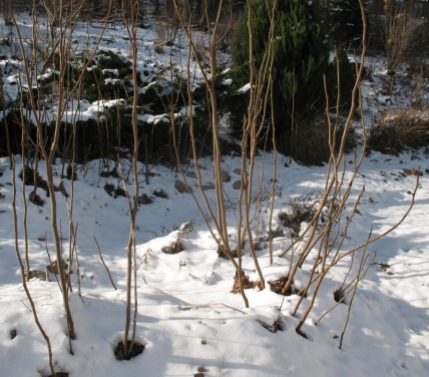Due to the severity of the several winters before last winter, all in-ground fig trees here were top-killed to the ground each of those winters, apart from trunks and limbs bent over to the ground and buried in mulch (all of which survived, as they do every year).
However, last winter (2016-2017), temperatures dropped only to 3 degrees Fahrenheit (-16 Celsius) a couple times, a mild winter here that allowed the wood of the fig bushes’ trunks and limbs to survive up to 4 feet above ground on many of the bushes, including trunks and limbs up to a maximum of 4 feet high on all of the bushes on relatively dry or well draining banks. The bushes at the bottoms of the banks or on more soggy banks all died back to the ground again last winter. Wet in summer, dry in winter for figs in harsh climates. (Sergio Carlini at Planet Fig explains.)
The bushes that did not die all the way back to the ground produced more figs than the ones that did, though all the Mt Etna bushes ripened figs regardless. An LSU Purple bush, despite dying all the way to the ground, and despite growing in only half-day sun, was the second best in-ground producer to Mt Etna.
Remains to be seen if any above ground fig wood will survive this winter where temperatures have bottomed out so far at -6 Fahrenheit (-21 Celsius).



great thread and info, thanks
LikeLike
Planet Fig also emphasizes basic factors in its article “The Fig Tree Resistance to Cold”:
“What action can be taken? It is obvious that for a gardener, it is impossible to prevent rain or modify the climate. However, it is possible to avoid planting a fig tree where water stagnates. If the plant stays in a humid environment, it will continue to gorge itself with water. It is then mandatory to select arid or at least very well drained locations. Consequently, it is evident that hills or sloping land are the ideal sites. Basically, a deep draining system is fundamental.” http://www.planetfig.com/articles/fareng2589.html
LikeLike
Hi. Do you have any Florea/Michurinska 10 in the ground? I am wondering how they survive and fruit after winter compared to Mt Etna.
Best regards,
KCR
LikeLike
I’m wondering too. I’ll trial Florea and a number of additional varieties in ground this coming year.
LikeLike
Great TC ! We start a new feed talking about our experiments “grounded fig in cold climate, witch do ?”
Nice !
Here in MTL aera (zone 5b), I’ll try this coming year, Longue d’aout and Montreal Redneck (a brown turkey familly)…and some others cold resistant
LikeLike
This is the first report I’ve heard of an LSU Purple fruiting after winter topkill. Makes me even more excited about getting one in the ground here in Kentucky. Thanks for sharing your experiences, Tony! Hope all your figs come through this winter o.k.
LikeLike
Will be some serious dieback here again this year, especially since I don’t protect the trunks and limbs. Will it be total topkill? Will have to wait and see. LSU Purple has fruited here unprotected after total topkill three years in a row now, joining the ranks of Improved Celeste, Brooklyn White, and Ronde de Bordeaux so far. Also of course Mt Etna which is far and away the most productive here unprotected in ground.
LikeLiked by 1 person
Wow, thanks for sharing your data experiment “grounded fig tree” in cold climate. Here in Montreal area (zone 5b) we took this winter -38°C on alternated 6-7 days !!!! (this is rare temperature, ie here the average coldest its -10°C in winter). This years, i’ll try to plant in Montréal’s soil your Mt-Ena to see if the roots will survive each year… (glade if you want to do a special cutting shipping to Montreal !)
Regards,
F.B.
LikeLike
There’s nothing special about my Mt Etna fig bushes in the sense that “Mt Etna” is simply a generic name for this variety that people in Canada and the US and all over the world grow by many other names, such as: Hardy Chicago, Marseilles Black, Dark Portuguese, and on and on and on. You are probably already growing it, or if not have ready access to it by a number of names in Canada.
LikeLike
All my in ground roots survive (with protection and without protection), i protect with homemade box of wood and insulate rockwool, the unprotected is cover with straw… all same constat, above ground wood die… inside box branch is killed by moisture… too much humidity.
LikeLike